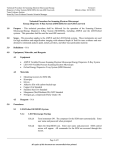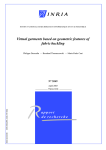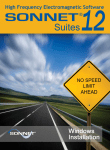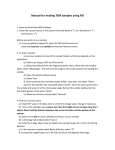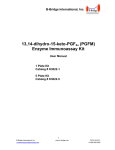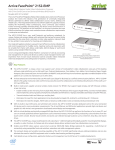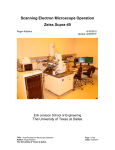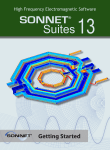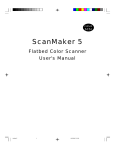Download Technical Procedure for Scanning Electron Microscope/ Energy
Transcript
Technical Procedure for Scanning Electron Microscope/Energy Dispersive X-Ray System (SEM/EDX) for non-GSR Casework Trace Evidence Section Version 3 Effective Date: 09/30/2013 Technical Procedure for Scanning Electron Microscope/ Energy Dispersive X-Ray System (SEM/EDX) for non-GSR Casework 1.0 Purpose – This technical procedure shall be followed for the operation of the Scanning Electron Microscope/Energy Dispersive X-Ray System (SEM/EDX), including ASPEX and the LEO/Oxford systems. This procedure shall be used for non-GSR casework. 2.0 Scope – This procedure applies to the ASPEX and the LEO/Oxford systems. These instruments are used for high resolution and magnification imaging with enhanced depth of field for trace evidence and nondestructive elemental analysis paint, metals, powders, and other trace particulate material. 3.0 Definitions – N/A 4.0 Equipment, Materials, and Reagents 4.1 Equipment • • • 4.2 Materials • • • • • • • • 4.3 5.0 ASPEX Variable Pressure Scanning Electron Microscope/Energy Dispersive X-Ray System LEO 1450 Variable Pressure Scanning Electron Microscope Oxford Energy Dispersive X-ray System (SDD Detector) Mounting tweezers for SEM lifts Kimwipes Gloves Adhesive lifts with carbon-backed tape Copper (Cu) Standard Stainless Steel 316 Standard Manganese (Mn)/Rhodium (Rh) 5492 Standard Nitrogen gas, compressed (Purity Grade 5.0) Reagents – N/A Procedures 5.1 LEO/Oxford SEM/EDX System 5.1.1 LEO Microscope Startup 5.1.1.1 Turn instrument ON. The computer for the SEM starts automatically. Enter user name and password when prompted. 5.1.1.2 Open the SmartSEM icon. Enter user name and password. SEM control screen will appear. All commands for the SEM are accessed through this screen. Page 1 of 9 All copies of this document are uncontrolled when printed. Technical Procedure for Scanning Electron Microscope/Energy Dispersive X-Ray System (SEM/EDX) for non-GSR Casework Trace Evidence Section 5.1.2 Version 3 Effective Date: 09/30/2013 5.1.1.3 Open Fantasia Software. Open RemCon32 Software. 5.1.1.4 Click on the Vacuum option on the Status Toolbar and select VENT. Select YES at the prompt. Unlatch both chamber door latches and adjust nitrogen pressure to 3-4 psi. Turn off nitrogen supply after chamber is finished venting. 5.1.1.5 Pull out stage chamber door to access stage holder. Using gloves, remove the stage holder and place it on a clean surface. 5.1.1.6 Using mounting tweezers, place samples in the holder and note position of each sample. Tighten the screws on the holder for each mount position. Place the holder back on the stage, ensuring that the flat edge of the mount is against the flat area of the stage. 5.1.1.7 Roll the stage back into the chamber and securely latch the chamber door latches. 5.1.1.8 Click the Vacuum option on the Status Toolbar and select PUMP. Wait for system to pump down. 5.1.1.9 Turn on the Extra High Tension (EHT) and Filament by clicking on GUN in the right bottom corner of screen and select BEAM ON. The last saved working conditions shall be automatically brought up for the filament. In emission mode, check to determine if the filament is properly aligned and saturated. Adjust emission image and filament by going to User Toolbar, Beam, and Gun Alignment. Use the electronic positioning adjustments to center the fully saturated emission image. 5.1.1.10 Adjust saturation of the filament slightly below or at the second crossover. 5.1.1.11 Adjust the working parameters of the instrument as necessary by accessing Tools through the User Toolbar, and “Go to Control Panel.” Oxford EDX Start-Up 5.1.2.1 Turn computer on by pressing the power button located on the HP computer in lower right area of the EDS table. 5.1.2.2 Login to INCA user by clicking on INCA. Enter password. 5.1.2.3 Double click on the INCA icon on the desktop. 5.1.2.4 Select Detector Control…in the Options menu. In Thermal Tab, the “Detector State” shall say “operate” and “COLD” and in the Slide tab the Slide Position shall say “in.” Close window. 5.1.2.5 Select Microscope Control… in the Options menu. Check the box for “HV.” Close window. Page 2 of 9 All copies of this document are uncontrolled when printed. Technical Procedure for Scanning Electron Microscope/Energy Dispersive X-Ray System (SEM/EDX) for non-GSR Casework Trace Evidence Section 5.1.3 Version 3 Effective Date: 09/30/2013 Performance Check for the LEO OXFORD System 5.1.3.1 5.1.3.2 A quantitative performance check is required whenever quantitative results are needed. 5.1.3.1.1 Using either a Copper or Manganese Standard, in INCA, select the Quant Optimization icon in the navigation pane. 5.1.3.1.2 Obtain an optimal image by adjusting the microscope settings. 5.1.3.1.3 Use a minimum Acquisition Rate of 4 for optimum resolution. 5.1.3.1.4 Select the element of choice. Once the element selection is made, this program runs automatically. The system will state the quantification was successful when finished. Resolution vs. Process Time Check – Performed monthly if in use. 5.1.3.2.1 User must exit INCA software to access the program for this check. 5.1.3.2.2 Click INCA Monitor icon in task bar in lower right corner. 5.1.3.2.3 Select Options, Monitor Options, and Engineer login. Enter the password. 5.1.3.2.4 In “Test Details” tab, Highlight Resolution vs. Process Time then click “add.” Select “next.” Follow prompts until it asks for user to adjust counts on a standard. 5.1.3.2.5 Load a standard such as Manganese, then adjust count rate between 4000 and 8000 counts using SEM spot size. (Do not follow the on screen suggestion of 1000 counts; that specific criterion is only for detectors cooled by liquid nitrogen and is not the criterion for the SDD detector.) 5.1.3.2.6 Follow the prompts. 5.1.3.2.7 Pass Criteria: The extrapolated strobe resolution at process time 5 or 6 shall be no greater than the detector resolution of 127 eV. If resolution requirement is not met, maintenance shall be performed or a service engineer called. Once maintenance is performed and this criterion is met, the instrument may be returned to service. 5.1.3.2.8 When test is complete, select REPORT icon in Navigator Pane and Print. Page 3 of 9 All copies of this document are uncontrolled when printed. Technical Procedure for Scanning Electron Microscope/Energy Dispersive X-Ray System (SEM/EDX) for non-GSR Casework Trace Evidence Section 5.1.4 5.1.5 5.1.6 Version 3 Effective Date: 09/30/2013 5.1.3.2.9 Load and analyze the Stainless steel 316 Standard. Print report. Pass Criteria - The following peaks should be present: Fe, Ni, Si, Mo, Cr, and Mn. If these peaks are not present, maintenance shall be performed or a service engineer called. Once maintenance is performed and this criterion is met, the instrument may be returned to service. 5.1.3.2.10 Fill out LEO/Oxford SEM-EDX Performance Check Log and place all printed reports in LEO/Oxford Notebook. Performance Verification for New Instrument Set-Up 5.1.4.1 A new SEM with EDX detector shall be installed by a certified engineer according to the manufacturer’s guidelines. 5.1.4.2 Spectra shall be obtained from a Manganese/Rhodium 5492 Standard, Copper Standard and a Stainless Steel 316 Standard. Collection and Storage of Data (Non GSR) on LEO SEM 5.1.5.1 Set the parameters of the LEO SEM instrument (e.g., different accelerating voltage, current setting, signal collector, or display variable), based on training and experience, to enhance the image on the display monitor. 5.1.5.2 Perform sizing of particles if needed. 5.1.5.3 Label pertinent information on the monitor using Annotation drop down menu. 5.1.5.4 Save images and/or annotation to the hard drive. 5.1.5.5 Print image and import into Forensic Advantage (FA) Case Record. Collection and Storage of Data (Non GSR) on OXFORD EDS 5.1.6.1 Use Acquisition Rate 3 for most analysis. If performing quantification, a higher process time of 4/5/6 may be needed, depending on sample type. 5.1.6.2 Analysis time will vary, with 100 seconds being an average time. 5.1.6.3 Click on “Point and ID” icon in the Navigator Pane. To set up analysis, follow the sequential steps in the navigator pane, starting with “PROJECT.” Save the project with a unique name before starting analysis. 5.1.6.4 During and after collection you may expand different regions of the spectra and identify spectral peaks either automatically or manually. 5.1.6.5 Once spectral peaks are identified and confirmed, save project to the hard drive. Page 4 of 9 All copies of this document are uncontrolled when printed. Technical Procedure for Scanning Electron Microscope/Energy Dispersive X-Ray System (SEM/EDX) for non-GSR Casework Trace Evidence Section Effective Date: 09/30/2013 5.1.6.6 5.1.7 5.2 Version 3 Print spectra in .pdf format and save in FA Case Record. Shut-Down Procedures 5.1.7.1 Turn off the filament by clicking “ALL” in the lower right corner of SmartSEM software. Close the SEM operating window and answer the dialog questions. 5.1.7.2 Close the SEM user software. Close the EMServer. Close the RemCon32 software. 5.1.7.3 Shut down the computer. 5.1.7.4 Once computer is shutdown, press the yellow “STANDBY” button on the front panel of the instrument to keep the electronics on, but in a standby mode. Pressing the red “OFF” button will remove all the voltage to the instrument and will lose stage settings. Therefore, never press the red “OFF” button except for major resetting of the instrument or for servicing of the system. 5.1.7.5 Close all windows in INCA software and shut down the computer. 5.1.8 Standards and Controls – This instrument requires the use of Manganese/Rhodium 5492 standard for performance checks. In addition the Stainless Steel 316 Standard shall be used for performance verifications. These standards have no special storage requirements. 5.1.9 Instrument Maintenance – Routine maintenance shall be performed such as changing pump oil, checking liquid chiller status, and replacing a filament. Any maintenance performed shall be documented in the maintenance logbook for that particular instrument. ASPEX Variable Pressure SEM/EDX 5.2.1 Start-Up Procedure & Loading of Samples 5.2.1.1 Turn instrument ON. Enter user name and password when prompted. The ASPEX engine will start automatically. 5.2.1.2 After ASPEX engine loads, double click “Perception” icon. 5.2.1.3 Move black lever on the stage from the downward position towards the upward position. This will begin the process of venting the chamber. The black lever will automatically move to the full upward position once the chamber is at atmospheric pressure. Page 5 of 9 All copies of this document are uncontrolled when printed. Technical Procedure for Scanning Electron Microscope/Energy Dispersive X-Ray System (SEM/EDX) for non-GSR Casework Trace Evidence Section 5.2.2 Version 3 Effective Date: 09/30/2013 5.2.1.4 Pull the stage from the microscope column and load the sample(s) into the specimen holder using mounting tweezers. Insert specimen holder into stage and tighten the thumb screw on the right side of the stage. 5.2.1.5 Gently slide stage back inside the microscope column. Push black lever downward to begin the vacuum process. Choose “Variable Pressure” checkbox in the Perception software. Default variable pressure setting is 0.1 Torr. Click Power Button (turns bright green when power is ON and SEM/EDX is at proper vacuum). 5.2.1.6 Set stage point to copper standard. Saturate the beam and align filament at 20 kV by adjusting the filament drive up to around 68 % or until an image appears. Turn the filament drive up slowly until the image is at maximum brightness. Select “Source Image Mode” from the drop down menu to view the emission image. Adjust filament drive until the emission image is slightly under saturation. Select “Line Scan” option from the drop down menu. Adjust the X and Y axis controls to adjust the line scan to its maximum height. Close the “Line Scan” mode. Performance Check – Required once a month by the first person to use that instrument in the month while in use. 5.2.2.1 Load a Copper standard; saturate the beam and align the filament at 20 kV. Obtain an image of the standard and focus on it. 5.2.2.2 Select Control, Right Mouse click and click on Calibrate from the dropdown menu. 5.2.2.3 Collect X-Ray spectra of the Copper Standard. The zero offset and gain of the pulse processor are being extracted while the spectrum is being collected. When the pulse processor is calibrated, zero and gain will be displayed in Green. Record the date, value of the Gain (10.000 ±5 %), and initials on the Aspex Monthly Calibration Log. 5.2.2.4 Pass Criteria: The value of the Gain shall be 10.000 ±5 %. If this value is not obtained, maintenance shall be performed or a service engineer called. Once maintenance is performed and this criterion is met, the instrument may be returned to service. 5.2.2.5 Remove Copper Standard from stage and load the Stainless Steel 316 Standard. 5.2.2.6 Saturate the beam and align the filament at 20 kV. Obtain an image of the standard and focus on it. Identify the peaks and save the spectra. 5.2.2.7 Print out the spectra and place in the Aspex Monthly Performance Check Manual. Page 6 of 9 All copies of this document are uncontrolled when printed. Technical Procedure for Scanning Electron Microscope/Energy Dispersive X-Ray System (SEM/EDX) for non-GSR Casework Trace Evidence Section Effective Date: 09/30/2013 5.2.2.8 5.2.3 5.2.4 5.2.5 Version 3 Pass Criteria - The following peaks should be present: Fe, Ni, Si, Mo, Cr, and Mn. If these peaks are not present, maintenance shall be performed or a service engineer called. Once maintenance is performed and this criterion is met, the instrument may be returned to service. Performance Verification for New Instrument Set-Up 5.2.3.1 A new SEM with EDX detector shall be installed by a certified engineer according to the manufacturer’s guidelines. 5.2.3.2 Spectra shall be obtained from a Copper standard and a Stainless Steel 316 standard. 5.2.3.3 If the spectra are acceptable and all major peaks identified, the instrument is approved for use in casework. Collection and Storage of Data (Non GSR) on ASPEX 5.2.4.1 Set the parameters of the ASPEX instrument, based on training and experience, to enhance the image on the display monitor. 5.2.4.2 Perform sizing of particles if needed. 5.2.4.3 Label pertinent information on the monitor using Annotation. 5.2.4.4 Save images and/or annotation to the hard drive. 5.2.4.5 Collected x-ray data. User may have to adjust spot size and restart to achieve optimal dead time collection. Analysis time will vary, with 100 seconds being an average time. 5.2.4.6 During and after collection you may expand different regions of the spectra and identify spectral peaks either automatically or manually. 5.2.4.7 Once spectral peaks are identified and confirmed, save spectra to the hard drive. 5.2.4.8 Print image and spectra and save in FA Case Record. Shut Down Procedure 5.2.5.1 The SEM vacuum always remains on. 5.2.5.2 Ensure that the X-Ray system is not actively collecting spectra. 5.2.5.3 Turn filament drive to 0 % and close Perception software. 5.2.5.4 Select Start icon then Shut Down. Page 7 of 9 All copies of this document are uncontrolled when printed. Technical Procedure for Scanning Electron Microscope/Energy Dispersive X-Ray System (SEM/EDX) for non-GSR Casework Trace Evidence Section Effective Date: 09/30/2013 5.2.6 Standards and Controls – This instrument requires the use of a Copper Standard for performance check. In addition, the Stainless Steel 316 standard is used for performance verifications. These standards have no special storage requirements. 5.2.7 Instrument Maintenance – Routine maintenance shall be performed such as changing pump oil, changing out a filament, etc. Any maintenance performed shall be documented in the maintenance logbook for that particular instrument. 5.3 Sampling and Sample Selection – No sampling is performed. When sample selection occurs, it shall be based on the Forensic Scientist’s training and experience. 5.4 Calculations - N/A 5.5 Uncertainty of measurement - N/A 6.0 Limitations – N/A 7.0 Safety Concerns 8.0 Version 3 7.1 The greatest safety concern is radiation from the X-ray tube. The x-ray system is monitored for leaks on a regular basis. 7.2 There is high voltage/current which can cause electrocution. Avoid contact with any live circuitry components. Potentially lethal voltages exist with the high voltage x-ray supply. References ASPEX, LLC. Personal SEM Console User Manual: Perception Suite User Documentation. Version 1.37, 2002. Carl Zeiss SMT Nano Technology Division. SmartSEM Operating Software for Felid Emission Scanning Electron Microscopes Manual. V05.04, Printed 2009. Hearle, J.W., J.T. Sparrow and P.M. Cross. The Use of the Scanning Electron Microscope. Oxford: Pergamon Press Ltd, 1972. Oxford Instruments Analytical. INCA Energy Operator Manual Issue 1. Printed 2004. (Located on Desktop of X-ray computer). Oxford Instruments Analytical. computer), 2007. 9.0 INCA Feature Instruction Manual. (Located on Desktop of X-ray Records • • • • LEO-Oxford SEM/EDX Performance Check Log Maintenance Log ASPEX SEM/EDX Performance Check Log Request for Instrumental Examination of Evidence Page 8 of 9 All copies of this document are uncontrolled when printed. Technical Procedure for Scanning Electron Microscope/Energy Dispersive X-Ray System (SEM/EDX) for non-GSR Casework Trace Evidence Section 10.0 Version 3 Effective Date: 09/30/2013 Attachments – N/A Revision History Effective Date Version Number 09/17/2012 1 02/01/2013 2 09/30/2013 3 Reason Original ISO Document Request for Instrumental Examination of Evidence was added as a record. 5.1.3.2 - Removed from performance check that it shall be performed by first person to use the instrument Page 9 of 9 All copies of this document are uncontrolled when printed.









